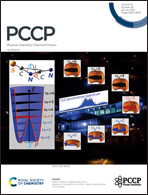LC567: a new 2D semimetallic carbon allotrope as a promising anode material for lithium-ion batteries†
Abstract
A novel two-dimensional carbon allotrope has been proposed using density functional theory (DFT) calculations. The cell contains 24 carbon atoms and is composed of five-, six-, and seven-membered rings, named LC567. It is low in energy and has excellent dynamic, thermal, and mechanical stability. Our results demonstrate that the theoretical capacity of monolayer LC567 is up to 1117 mA h g−1, and the lithium diffusion barrier is also very low, around 0.18 eV, which is superior to graphene and most reported two-dimensional anode materials. In addition, LC567 exhibits quite low open circuit voltage during the process of Li ion insertion. For the bulk of LC567, it still exhibits high capacity and ideal open circuit voltage, revealing its potential application as an anode for lithium batteries. Meanwhile, we discuss the mechanism of the high capacity and low diffusion barrier of LC567 as an anode material for lithium batteries, and find that the high capacity and low diffusion barrier properties may be related to the pentagonal carbon rings (C5).



 Please wait while we load your content...
Please wait while we load your content...